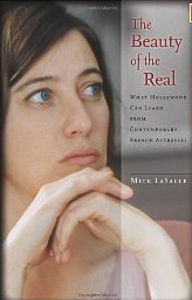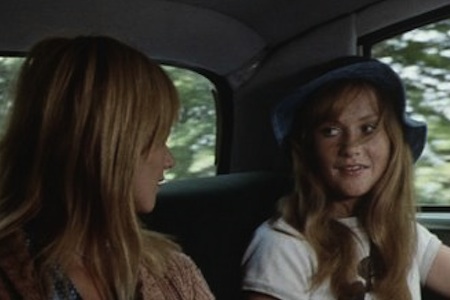Streaming offers a variety of instant gratifications, including one of the best ways to enjoy one of the better film books published this year, Mick LaSalle’s The Beauty of the Real: What Hollywood Can Learn from Contemporary French Actresses. I recently used LaSalle’s cinematic Michelin guide to compile a list of five themes on French actresses (and one female director) that can be observed and expanded upon with what’s available on Fandor. Part of LaSalle’s premise is how we are missing a halcyon period of great French actresses since a considerable number of the films he discusses are unavailable in the U.S. But enough are accessible here online to underscore the wider argument LaSalle makes in his book: that Hollywood has much to learn from the more fulfilling roles developed for, and often by, the women in the French film industry.
1. The Great Isabelle Huppert
LaSalle credits the 1974 anarchic comedy Going Places (Bertrand Blier) as the film that announced French actress Isabelle Huppert was indeed going places herself. Although, of course, the better experience can be found watching the entire film, if you want to jump to the scene, it begins at 107 min and 43 seconds. The brevity of Huppert’s screen time is disproportionate to the impact. This teenage role, as LaSalle poetically puts it, “gives us a lot more than a whisper of things to come. It gives us the whole song, playing at full blast, music and lyrics included.” It is the beginning of Huppert’s “studies in perversity, for playing women of monumental strangeness, coldness, and selfishness.” (Other examples of Huppert’s genius: Hidden Love (Alessandro Capone, 2007) and Home (Ursula Meier, 2008) but those are an Italian/Belgian and a Swiss film respectively, and we’re sticking with the French in this list.)

2. The Senior Stateswoman and the Fresh Faces
LaSalle includes an appendix in his book that advises French cinema to brand itself in the U.S. as “the land of women’s cinema.” There is no better barometer for this female-fulfilling aspect of French cinema than taking the lack of films in the U.S. that revolve around women over 50 and comparing this lacunae with the many satisfying roles older French actresses can find and create throughout their lives in their national cinema. And LaSalle writes that no French actress found herself in more dynamic roles in the new century as she entered her half-century than Nathalie Baye. The film LaSalle considers “her defining showcase of the decade” is Le Petit Lieutenant (Xavier Beauvois, 2005 ). Originally written for a man, the role is commandeered by Baye, playing a recovering alcoholic police commandant who enters a unit at the same time as a young recruit who would be of similar age to her only son had her son not died of meningitis when he was seven. The film begins as if it will be a vehicle for the handsome Jelil Lespert, but quickly changes drivers, for it becomes a course for Baye’s practiced talent of portraying roles where “a woman’s rationality and fundamental decency are confronted by a world that cannot and never will live up to her expectations.” LaSalle spends a page talking about how Baye conveys this studied wisdom in the final shot, but this brilliance shines throughout the film, such as when her character finds both the bar and the AA meeting lacking in the sustenance her spirit needs.
Among the new French female talents mentioned in The Beauty of the Real are Isild Le Besco in her compelling black-and-white feature of young adult passion, A tout de suite (“Right Now,” Benoît Jacquot, 2004). Le Besco plays a directionless teenager who stumbles upon her muse in a young French man of Moroccan descent with whom she descends into a life as a runaway after her lover accidentally kills someone during a robbery. This film highlights one of the major differences between French and U.S. film. And I’m not speaking of the casual nudity and sex. It’s the fact that this young adult makes less than ideal choices but is not pummeled with comeuppance based on the demands of American screen morality. Le Besco is a joy to watch. As LaSalle puts it, she’s “capable of looking pretty and scary by turns, and sometimes both simultaneously” and A tout de suite exemplifies a particular aspect of Le Besco’s work, “her capacity to convey the misery, confusion and sheer torment of being young.”
3. The Battle for the Best Actress César Award
As we know, the French equivalent to the Oscars is the César. One woman who has won a few Best Actress Césars is Isabelle Adjani. And in 2009, she was up against a strong field of best actresses and won for her role in Skirt Day (Jean-Paul Lilienfeld, 2009) where she plays a teacher of disadvantaged youth. Provoked one too many times, she explodes and holds her students hostage. LaSalle argues Adjani was the least-deserving choice for the award in 2009. But decide for yourself as you watch it up against one of the other, and in LaSalle’s opinion, stronger contenders for the Best Actress César that year: Sandrine Kiberlain’s turn in Mademoiselle Chambon (Stéphane Brizé).
A story about a traveling schoolteacher, we witness that Kiberlain’s character is very good at her job, but we also witness her fail at romantic love, hinting at the motivation for her nomadic tendencies. One of the many aspects of French cinema and French actresses highlighted in Mademoiselle Chambon is the fact that the sex in the affair is not depicted as the result of succumbing to an irresistible impulse, but is instead a calculated, rational decision. In addition, LaSalle states, “The French are very good at depicting the power dynamics within relationships, mainly because they’re willing to admit such dynamics exist.” As a result, the subtlety to such dynamics in Mademoiselle Chambon is partly what makes the film so engaging—along with Kiberlain’s execution of her character’s complexity and patience.
4. An Ensemble Piece of Great Actresses
If you are looking for a quick snapshot of evidence for what France allows for its actresses, you would do well to watch Israeli director Amos Gitai’s French production One Day You’ll Understand (Plus tard tu comprendras, 2008). It features Jeanne Moreau, Emmanuelle Devos, and Dominique Blanc. The film follows a reared-Catholic family as they wrestle with the matriarch’s (Moreau) late revelation that they have a secret Jewish history. All three women bring excellent performances to the screen, which demonstrate that women in French cinema don’t necessarily need to be the lead in order to have an impact. They are not types or characters set aside as plot devices for the focus on the male actors. They are integral to the story, never an afterthought.
And if, like me, you were struck by Devos, you can move on to watch her play the wife of a maybe/maybe-not psychotic husband in La Moustache (Emmanuel Carrère, 2005). (Yes, you can watch Frédéric Fonteyne’s 2004 feature Gilles’ Wife for even more Devos, but that’s technically a Belgian film, so I’m keeping it out of the discussion here.) Devos has to regularly shift the audience’s impression of her character as one who is sincere to one whose motives are questionable. Is she truly caring for her husband or is she manipulating him? It is partly to Devos’ credit that you leave this film not really knowing what to believe.
5. The Director
Agnès Varda has directed quite a few films, including the César-winning video essay The Beaches of Agnès (2008), the documentary The Gleaners and I (2000) and the short tribute to the Cinematheque Francaise, T’as de beaux escaliers, tu sais (1986). I say watch them all as an example of the space French cinema provides for women directors. But start with a short piece Varda made in 1975 as part of a “Year of the Woman” TV series in France: Résponse de femmes.
Discussing her book How the French Invented Love: Nine Hundred Years of Passion and Romance on a recent radio interview on KQED’s Forum with Michael Krasny, author Marilyn Yalom notes how “Love, as far as the French are concerned, is embedded in the flesh.” Varda’s Response de Femmes directly confronts the viewer with that flesh-formed love, displaying before us a diverse array of confidently naked women’s bodies, including old and pregnant bodies. After daring her viewers not to avert their gaze, (even amongst the naked-friendly French, some found the laughing pregnant lady a bit too much), she finished the short piece with the following exchange. On screen woman: “I am woman. And woman must be reinvented.” Offscreen male voice: “Then, love must be reinvented.”
Even though LaSalle’s book doesn’t mention this short, his focus being on French actresses, not female directors, Response de Femmes underscores much of his premise, that the French know love whereas Americans know pyrotechnics and other special effects. The French work less with special effects, instead choosing to work with the affects that make us special. They have turned the limitations of smaller budgets into an advantage. They have had to reinvent how they represent the portrayal of love on screen. As a result, they have reinvented women on screen as fully fleshed in that humanity.





